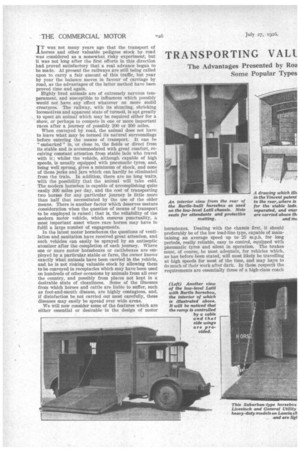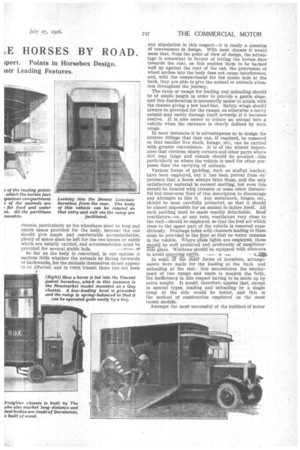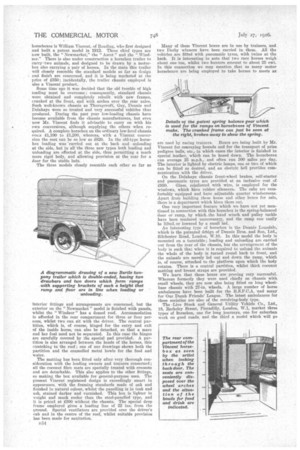TRANSPORTING VALI_ ,E HORSES BY ROAD.
Page 16

Page 17

Page 18

Page 19

If you've noticed an error in this article please click here to report it so we can fix it.
IT was not many years ago that the transport of horses and other valuable pedigree stock by road was considered as a somewhat risky experiment, but It was not long after the first efforts in this direction hadproved satisfactory that a real advance began to be made. At present the railways are still being called upon to carry a fair amount of this traffic, but year by year the balance moves in favour of carriage by road, as the advantages of the latter method have been proved time and again.
Highly bred animals are of extremely nervous temperament, and susceptible to influences which possibly would not have any effect whatever on more stolid creatures. The railway, with its shunting, shrieking locomotives and apparent state of turmoil, is apt greatly to upset an animal which may be required either for a show, or perhaps to compete in one or more important races after a journey of possibly 200 or 300 miles.
When conveyed by road, the animal does not have to leave what may be termed its natural surroundings before entering the means of transport. It can be " embarked " in, or close to, the fields or direct from its stable and is accommodated with great comfort, receiving constant attention from stable lads who travel with it ; whilst the vehicle, although capable of high speeds, is usually equipped with pneumatic tyres, and, being well sprung, gives a minimum of shock, and none of those jerks and jars which can hardly be eliminated from the train. In addition, there are no long waits, with the possibility that the animal will take cold. The modern horsebox is capable of accomplishing quite easily 300 miles per day, and the cost of transporting two horses for any particular journey is little more than half that necessitated by the use of the older means. There is another factor which deserves mature consideration when the question of means of transport to be employed is raised ; that is, the reliability of the modern motor vehicle, which ensures punctuality, a most important asset where race horses may have to fulfil a large number of engagements.
In the latest motor horseboxes the questions of ventilation and sanitation have received great attention, and such vehicles can easily be sprayed by an antiseptic atomizer after the completion of each journey. Where one or more motor horseboxes or cattieboxes are employed by a particular stable or farm, the owner knows exactly what animals have been carried in the vehicle, and he is not risking valuable stock by allowing them to be conveyed in receptacles which may have been used on hundreds of other occasions by animals from all over the country, and possibly from places not kept in a desirable state of cleanliness. Some of the illnesses from which horses and cattle are liable to suffer, such as foot-and-mouth disease, are highly contagious, and, if disinfection be not carried out most carefully, these diseases may easily be spread over wide areas.
We will now consider some of the features which are either essential or desirable in the design of motor
horseboxes. Dealing with the chassis first, it should preferably be of the low load-line type, capable of maintaining an average Speed up to 25 m.p.h. for long periods, really reliable, easy to control, equipped with pneumatic tyres and silent in operation. The brakes must, of course, be most adequate, for vehicles which, as has before been stated, will most likely be travelling at high speeds for most of the time, and may have to do much of their work after dark. In these respect's the requirements are essentially those of a high-class coach
chassis, particularly as the wheelbase must be long and ample space provided for the body, because the cab should give ample and comfortable accommodation, plenty of space must be left for the two horses or cattle which are usually carried, and accommodation must he provided for several stable lads. 4.1sr So far as the body is concerned, in our opinion it matters little whether the animals be facing forwards or backwards, for the animals themselves do not appear to be affected, and in train transit there has not been any stipulation in this respect—it is really a question of convenience in design. With most chassis it would seem that, from the point of view of design, the advantage is somewhat in favour of letting the horses face towards the rear, as this enables them to be backed well up against the rear of the cab, the protrusion of wheel arches into the body does not cause interference, and, with the compartment for the stable lads at the back, they are able to give the animal or animals attention throughout the journey.
The ramp or ramps for loading and unloading should be of ample length in order to provide a gentle slope, and this desideratum is necessarily easier to attain with the chassis giving a low load-line. Safety wings should always be provided for the ramps, as otherwise a nervy animal may easily damage itself severely. if it becomes restive. It is, also easier to induce an animal into a vehicle when the entrance is clearly defined by such wings.
In most instances it is advantageous so to design the interior fittings that they can, if required, be removed so that smaller live stock, forage, etc., can be carried with greater convenience. It is of the utmost importance that crevices, sharp corners and other parts where dirt may lodge and remain should be avoided—this particularly so where the vehicle is used for other purposes than the carrying of animals.
Various forms of padding, such as stuffed leather, have been employed, but it has been proved from experience that a horse always bites these, and the only satisfactory material is coconut matting, but even this should be treated with creosote or some other distasteful but innocuous fluid of this description to discourage any attempts to bite it. Any metalwork, hinges, etc., should be most carefully protected, so that it should be almost impossible for an animal to injure itself. All such padding must be made readily detachable. Roof ventilators—or, at any rate, ventilators very close to the roof—should be employed, so that the foul air which rises to the upper part of the vehicle is removed expeditiously. Drainage holes with channels leading to them must be provided in the floor so that no water remains in the vehkle. Where eas lights are employed, these should be well prote-Cted and preferably of unsplinter;W lais. Windows should be equipped with silencers to avoid annoying rattle. 414110 In soniF172fl1 ziaa forms of horsebox, arrangements were made for the loading at the back and unloading at the side: this necessitates the employment of two ramps and tends to weaken the body, the inefficiency in this respect having to be made up by extra weight. It would, therefore, appear that, except in special types, loading ad unloading by a single ramp at the side would be better, and this is the method of construction employed on the most recent models.
Amongst the most successful of the builders of motor
horseboxes is William Vincent, of Reading, who first designed and built a patent model in 1912. Three chief types are now built, the " Newmarket," the " Ascot " and the " Windsor." There is also under construction a horsebox trailer to carry two animals, and designed to be drawn by a motorbox also carrying a pair of horses. In the main this trailer will closely resemble the standard models so far as design and finish are concerned, and it is being marketed at the price of £350; incidentally, the trailer chassis employed is also a Vincent product.
Some time ago it was decided that the old trouble of high loading must be overcome; consequently, standard chassis were obtained and completely rebuilt with new frames, cranked at the front, and with arches aver the rear axles. Such well-known chassis as Thornycroft, Guy, Dennis and Delahaye were so treated and very successful vehicles thus produced. During the past year low-loading chassis have become available from the chassis manufacturers, but even now Mr. Vincent finds it advisable to carry on with his own conversions, although supplying the others when required. A complete horsebox on the ordinary low-level chassis costs £1,100 to £1,200, whereas, with a Vincent conversion the cost can be so low as £820. In the old-type horsebox loading was carried out at the back and unloading at the side, but in all the three new types both loading and unloading are effected at the side, thus permitting a much more rigid body, and allowing provision at the rear for a door for the stable lads.
The three models closely resemble each other so far as interior fittings and arrangements are concerned, but the exterior on the " Newmarket " model is finished with panels, whilst the " Windsor " has a domed roof. Accommodation is afforded in the rear compartment for three or four persons, whilst two can sit with the driver. The central partition, which is, of course, hinged for the entry and exit of the inside horse, can also be detached, so that a mare and her foal need not be separated. In this case the hinges are carefully covered by the special pad provided. A partition is also arranged between the heads of the horses, this stretching to the roof ; one of our drawings shows both the partition and the enamelled metal bowls for the feed and water.
The matting has been fitted only after very thorough consideration with the leading owners and trainers concerned ; all the coconut fibre mats are specially treated with creosote and are detachable. This also applies to the other fittings, so making the box available for general-purpose uses. The present Vincent registered design is exceedingly smart in appearance, with the framing standards made of oak and finished in natural colour, whilst the panelling is in teak and ash, stained darker and varnished. This box is lighter in weight and much cooler than the steel-panelled • type, and it is priced at £300 without the chassis. The special drop frame employed gives a loading line of 22 ins. from the ground. Special ventilators are provided over the driver's cab and in the centre of the roof, whilst suitable provision has been made for sanitation.
Many of these Vincent boxes are in use by trainers, and two Derby winners have been carried in them. All the vehicles are fitted with pneumatic tyres, with twins at the back. It is interesting to note that two race horses weigh about one ton, whilst two hunters amount to about 25 cwt. In this connection we may mention that as many motor horseboxes are being employed to take horses to meets as are used by racing trainers. Boxes are being built by Mr. Vincent for conveying hounds and for the transport of prize pedigree bulls, etc.,in which cases the interior is finished in special leather, which can be hosed down. The horseboxes can average 25 m.p.h., and often run 300 miles per day. The interior is lighted by electric lamps, one or two of which can be fitted as desired, and an electric bell provides communication with the driver.
On the Delahaye chassis front-wheel brakes, self-starter and pneumatic tyres are provided at an inclusive cost of "i950. Glass, reinforced with wire, is employed for the windows, which have rubber silencers. The cabs are comfortably equipped and have adjustable quarter windscreens. Apart from building these horse and other boxes for sale, there is a department which hires them out. One very important feature which we have not yet mentioned in connection with this horsebox is the spring-balanced door or ramp, by which the hand winch and pulley tackle have been rendered unnecessary, and the ramp can easily be lifted, or lowered by a small lad. An interesting type of horsebox is the Dennis Lonsdale, which is the patented dnign of Dennis Bros. and Son, Ltd., Silchester Road, London, W.10. In this model the body is mounted on a turntable ; loading and unloading are carried out from the rear of the chassis, but the arrangement of the body is such that when it is required to unload the animals the whole of the body is turned round back to front, and the animals are merely led out and down the ramp, which is, of course, attached to the platform upon which the body rotates. There is a central partition, whilst thick coconut matting and breast straps are provided. We learn that these boxes are proving very successful. Whereas formerly they were used chiefly on chassis with small wheels, they are now also being fitted on long wheelbase chassis with 27-in. wheels. A large number of horse ambulances have been built for the R.S.P.C.A. and many for Our Dumb Friends' League. The latest ambulances for these societies are also of the revolving-body type. The Live Stock and General Utility Vehicle Co., Ltd., 18, Berkeley Street, Piccadilly, -London, W.1, market three types of horsebox, one for long journeys, one for suburban work On good roads, and the third a model which will go pracdcally anywhere. We illustrate the " Suburban " type, in which the S.D. Freighter chassis is employed.
The loading line of the long-distance type, in which a Lancia chassis is employed, is approximately 30 ins. All three give the advantage of a ramp with a gentle sloe, which can be small and of such light construction that no winch is required. Safety wings are provided, although not actually shown in the box illustrated, and two horses or three ponies can be carried in any of the models by suitably arranging the interior fittings, which are demountable and interchangeable, so that the vehicle can, in addition, be used for other purposes. The bodies are built chiefly in Duralumin, which is infinitely stronger and more durable than wood. Also, there is a saving of approximately twothirds the weight as compared with the average Wood body. In the long-distance type, which will probably be that in greatest demand, as it is suitable for all kinds of work, the grooms' compartment is carried at the rear of the box, and contains the wheel arches, so that these do not intrude into the compartment for the horses, which are carried tail first. All the loading and unloading is done from the off side, thus necessitating one ramp only, which is slatted, with fibre matting beneath the slats. The floor is also finished with slats and provided with drainage holes. The third type, which is known as the heavy, is similar to that just described, but equipped with solid tyres and arranged to draw a trailer to carry extra horses. The respective prices of the three models are £700, £750 and rt5o, all without padding, and the trailer, with pneumatic tyres, is priced at approximately £500. The cost of padding depends upon the material, hut is approximately £50.
Many horseboxes for motor chassis have been built by James Bartle and Co., Ltd., Lancaster Road, Notting Hill, London, W.11, and one of the latest of their products is a two-wheeled trailer to carry two ponies. This is a particularly interesting type with a drawbar at each end, whilst the end doors are provided with protruding brackets, which, when the door is dropped, serve to support the trailer at such a height that the ramp formed by the door and the floor of the trailer are in line, the body itself rocking on its axle. This is a most convenient arrangement, as loading can be effected from one end and unloading from the other ; also, the animals can be carried facing either to the front or the back as desired. To give a low load-line the axle is cranked. The wheels are equipped with twin pneumatic tyres. The inside is, as usual, padded with coconut matting, and the top is covered with waterproof canvas. The length of the body is 10 ft, the width inside 5 ft. 6 ins, and the height inside 7 ft.
The company have also built a number of horseboxes on Latil chassis for the concessionnaires, L. C. Rawlence and Co., Ltd., 39, Sackville Street, London, W.1. We illustrate one of these and certain details. The Latil lends itself especially well to this work, as it has a very low load-line. Following the most modern practice, the largest portion of the off side drops to form a ramp, being lifted and lowered by means of tackle consisting of a wire rope passing over pulleys to a small winch at the near side of the cab. There is accommodation for stable lads at the back, and a separate door is provided for them. When travelling the horses face the rear.
Many visitors to the recent Royal Show will have noticed with interest the Reo chassis equipped with a horsebox body by Messrs. Ildetcalfes, of South Street, Romford, which was shown by Harris and Hasell, Ltd.






























